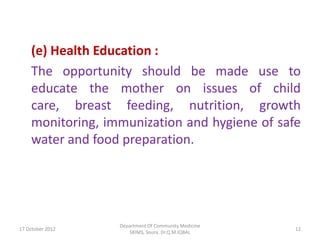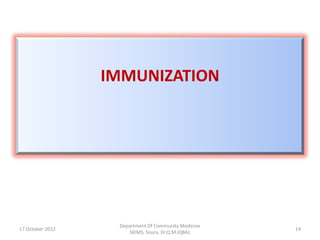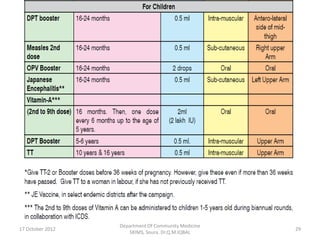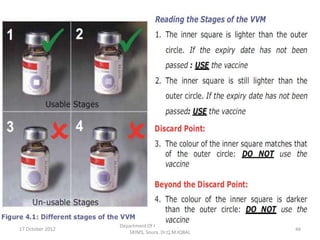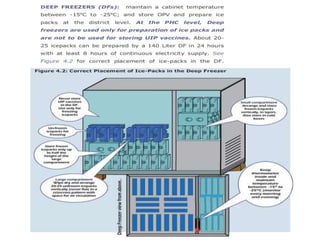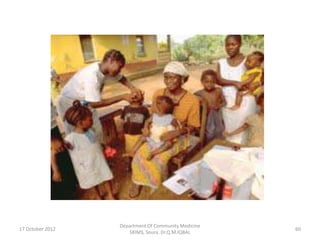Under fives clinic
- 1. UNDER FIVES CLINIC PRACTICAL DEMONSTRATION FOR 4TH SEMESTER Department Of Community Medicine 17 October 2012 1 SKIMS, Soura. Dr.Q.M.IQBAL
- 2. Under Fives-A Special Group 1. They constitute about 15 % of the total population. 2. They suffer high rates of mortality and morbidity. 3. The effects of malnutrition and other diseases have a role in later life. 4. The majority of the deaths are preventable through available interventions. 5. This is a period of growth and development. Department Of Community Medicine 17 October 2012 2 SKIMS, Soura. Dr.Q.M.IQBAL
- 3. 6. Brain growth is completed during 1st five years. 7. Most causes of morbidity are preventable by immunization. 8. Health of children under five years and family health are inter-related. Department Of Community Medicine 17 October 2012 3 SKIMS, Soura. Dr.Q.M.IQBAL
- 4. Department Of Community Medicine 17 October 2012 4 SKIMS, Soura. Dr.Q.M.IQBAL
- 5. Under five clinic is a center, where preventive, promotive, curative, referral and educational services are provided in a package manner to under five children under one roof. The services are made available through trained nurses, so that not only the services become economical but also becomes available to larger proportion of children population in the community. Department Of Community Medicine 17 October 2012 5 SKIMS, Soura. Dr.Q.M.IQBAL
- 6. GOAL The overall goal of the Under-Fives Clinic is to provide comprehensive health care to young children in a separate specialized facility. Department Of Community Medicine 17 October 2012 6 SKIMS, Soura. Dr.Q.M.IQBAL
- 7. The under five clinic is represented by traditional logo of a triangle with four internal triangles and an outer enveloping triangle as shown in the Fig. Department Of Community Medicine 17 October 2012 7 SKIMS, Soura. Dr.Q.M.IQBAL
- 8. Functions: (a) Care in Illness : This is the felt need of the mother and child for which any child is brought to the clinic. The usual illnesses encountered in children under five are fever, diarrhoea, ARI, infections of the skin and helminthiasis. The facility should provide for essential laboratory investigations and X-ray facilities. The Clinic should be backed by an effective referral mechanism. Department Of Community Medicine 17 October 2012 8 SKIMS, Soura. Dr.Q.M.IQBAL
- 9. (b) Growth Monitoring : This is one of the most important functions of the clinic. The child is weighed periodically – every month during the first year, every 2 monthly from 1 to 3 years of age and every 3 monthly in 4th and 5th years. Besides weighing, measuring height, mid arm circumference can also be carried out depending upon the availability of trained manpower and equipments. The growth is plotted on the growth chart and any faltering in the growth is detected and suitable action initiated. The milestones are also recorded and any delay in October 2012 17 achieving milestone is evaluated. Department Of Community Medicine SKIMS, Soura. Dr.Q.M.IQBAL 9
- 10. (c) Preventive Care : This involves primarily the immunization services during the 1st five years of life, vitamin A supplementation and administration of Iron supplementation and antihelminthic treatment to prevent anemia. The preventive care also provides for regular health check up and use of ORS during Diarrhoea to prevent dehydration from developing. 17 October 2012 Department Of Community Medicine 10 SKIMS, Soura. Dr.Q.M.IQBAL
- 11. (d) Family Planning : Family planning is central to any program directed towards women and children. The mothers are more receptive to family planning during early Puerperium and lactation. Mother is counselled on the various options available, their merits and de-merits so that she can make a choice. Department Of Community Medicine 17 October 2012 11 SKIMS, Soura. Dr.Q.M.IQBAL
- 12. (e) Health Education : The opportunity should be made use to educate the mother on issues of child care, breast feeding, nutrition, growth monitoring, immunization and hygiene of safe water and food preparation. Department Of Community Medicine 17 October 2012 12 SKIMS, Soura. Dr.Q.M.IQBAL
- 13. Department Of Community Medicine 17 October 2012 13 SKIMS, Soura. Dr.Q.M.IQBAL
- 14. IMMUNIZATION Department Of Community Medicine 17 October 2012 14 SKIMS, Soura. Dr.Q.M.IQBAL
- 15. Department Of Community Medicine 17 October 2012 15 SKIMS, Soura. Dr.Q.M.IQBAL
- 16. Why immunization? • Immunization is one of the safest and most effective methods of preventing childhood diseases. • Under the Universal Immunization Programme (UIP), significant achievements have been made in preventing and controlling the Vaccine Preventable Diseases (VPDs). • Immunization has to be sustained as a high priority to further reduce the incidence of all VPDs, control measles, eliminate tetanus and eradicate poliomyelitis. Department Of Community Medicine 17 October 2012 16 SKIMS, Soura. Dr.Q.M.IQBAL
- 17. • Full immunization (i.e. received one dose of BCG, three doses of DPT, Hep-B and OPV each and one dose of Measles before one year of age) gives a child the best chance for a healthy life. Preventing disease before it occurs saves money, energy, and lives. • Immunization is a key strategy to child survival. By protecting infants from VPDs, immunization significantly lowers morbidity and mortality rates in children. The security provided to families can lead to lower birth rates. • Immunization is an indicator of a strong primary health care system. Department Of Community Medicine 17 October 2012 17 SKIMS, Soura. Dr.Q.M.IQBAL
- 18. Reasons for Low immunization coverage • Failure to provide immunization. • Dropouts. • Unreached populations. • Resistant populations. • Missed Opportunities. Department Of Community Medicine 17 October 2012 18 SKIMS, Soura. Dr.Q.M.IQBAL
- 19. The following are the targeted vaccine preventable diseases along with their symptoms, mode of spread and methods of prevention. • Tuberculosis • Polio • Diphtheria • Pertussis • Tetanus • Hepatitis B • Measles Department Of Community Medicine 17 October 2012 19 SKIMS, Soura. Dr.Q.M.IQBAL
- 20. Tuberculosis • Tuberculosis (TB) is caused by a bacteria (Mycobacterium tuberculae). • It is a highly contagious disease that affects the lungs but can also affect the intestines, bones and joints, lymph glands, meninges, and other tissues of the body. Department Of Community Medicine 17 October 2012 20 SKIMS, Soura. Dr.Q.M.IQBAL
- 21. Polio Polio is a viral infection that affects the nervous system and can cause severe illness, paralysis, and even death. Due to intensive immunization campaigns, there has been a very significant decline of polio cases in the country since 1999. Department Of Community Medicine 17 October 2012 21 SKIMS, Soura. Dr.Q.M.IQBAL
- 22. Diphtheria Diphtheria is caused by bacteria (Coryne bacterium diphtherae). Diphtheria is an infectious disease that commonly infects the tonsils and pharynx, forming a membrane that can lead to obstructed breathing and death. Department Of Community Medicine 17 October 2012 22 SKIMS, Soura. Dr.Q.M.IQBAL
- 23. Pertussis (Whooping Cough) Pertussis, commonly known as whooping cough, is caused by bacteria (Bordetella pertussis). Pertussis is a highly contagious bacterial disease, involving the respiratory tract. It is characterized by repeated cough that may lead to aspiration and possible death, in a few cases. Department Of Community Medicine 17 October 2012 23 SKIMS, Soura. Dr.Q.M.IQBAL
- 24. Tetanus Tetanus is caused by bacteria (Clostridium tetani). People of all ages can become infected with tetanus. Department Of Community Medicine 17 October 2012 24 SKIMS, Soura. Dr.Q.M.IQBAL
- 25. Measles Measles is a highly infectious illness caused by a virus that can be found in the nose, mouth or throat of an infected person. Infection is characterized by fever, cough and spreading rash that may lead to death due to secondary infections like diarrhea and pneumonia. Department Of Community Medicine 17 October 2012 25 SKIMS, Soura. Dr.Q.M.IQBAL
- 26. Hepatitis B Hepatitis B is a highly infectious viral disease (40-100 times more infectious than HIV) and is the leading cause of jaundice, fulminant liver disease, cirrhosis and liver cancer. Department Of Community Medicine 17 October 2012 26 SKIMS, Soura. Dr.Q.M.IQBAL
- 27. Department Of Community Medicine 17 October 2012 27 SKIMS, Soura. Dr.Q.M.IQBAL
- 28. Department Of Community Medicine 17 October 2012 28 SKIMS, Soura. Dr.Q.M.IQBAL
- 29. Department Of Community Medicine 17 October 2012 29 SKIMS, Soura. Dr.Q.M.IQBAL
- 30. Administration summary: BCG vaccine Department Of Community Medicine 17 October 2012 30 SKIMS, Soura. Dr.Q.M.IQBAL
- 31. Administration summary: DTP vaccine Department Of Community Medicine 17 October 2012 31 SKIMS, Soura. Dr.Q.M.IQBAL
- 32. Administration summary: OPV Department Of Community Medicine 17 October 2012 32 SKIMS, Soura. Dr.Q.M.IQBAL
- 33. Administration summary: measles vaccine Department Of Community Medicine 17 October 2012 33 SKIMS, Soura. Dr.Q.M.IQBAL
- 34. Adverse Events Following Immunization (AEFIs) • What is an Adverse Event Following Immunization? An Adverse Event Following Immunization (AEFI) is a medical incident that takes place after an immunization, causes concern, and is believed to be caused by immunization. Department Of Community Medicine 17 October 2012 34 SKIMS, Soura. Dr.Q.M.IQBAL
- 35. Department Of Community Medicine 17 October 2012 35 SKIMS, Soura. Dr.Q.M.IQBAL
- 36. Department Of Community Medicine 17 October 2012 36 SKIMS, Soura. Dr.Q.M.IQBAL
- 37. Department Of Community Medicine 17 October 2012 37 SKIMS, Soura. Dr.Q.M.IQBAL
- 38. Department Of Community Medicine 17 October 2012 38 SKIMS, Soura. Dr.Q.M.IQBAL
- 39. Department Of Community Medicine 17 October 2012 39 SKIMS, Soura. Dr.Q.M.IQBAL
- 40. Cold Chain Department Of Community Medicine 17 October 2012 40 SKIMS, Soura. Dr.Q.M.IQBAL
- 41. The Cold Chain is a system of storing and transporting vaccines at recommended temperatures from the point of manufacture to the point of use. The key elements of the cold chain are: Personnel: to manage vaccine storage and distribution Equipment: to store and transport vaccine and to monitor temperature Procedures: to ensure that vaccines are stored and transported at appropriate temperatures Department Of Community Medicine 17 October 2012 41 SKIMS, Soura. Dr.Q.M.IQBAL
- 42. • Keeping vaccines at the right temperature is not an easy task, but the consequences of not doing so can be disastrous. Once vaccine potency is lost, it cannot be regained. • The damaged vaccines must be destroyed, leading to inadequate vaccine stocks and wastage of expensive vaccines. • Moreover, children and women who receive a vaccine that is not potent are not protected. Department Of Community Medicine 17 October 2012 42 SKIMS, Soura. Dr.Q.M.IQBAL
- 43. Department Of Community Medicine 17 October 2012 43 SKIMS, Soura. Dr.Q.M.IQBAL
- 44. Department Of Community Medicine 17 October 2012 44 SKIMS, Soura. Dr.Q.M.IQBAL
- 45. • The physical appearance of the vaccine may remain unchanged even after it is damaged. However, the loss of potency due to either exposure to heat or cold is permanent and can not be regained. Department Of Community Medicine 17 October 2012 45 SKIMS, Soura. Dr.Q.M.IQBAL
- 46. HEAT DAMAGE • All vaccines are damaged by temperatures more than +80C, whether they are exposed to a lot of heat in a short time (e.g., as a result of keeping vaccine in a closed vehicle in the sun) or a small amount of heat over a long period (e.g., as a result of the frequent opening of lid of ILR). • Reconstituted BCG, measles and JE vaccines are the most sensitive to heat and light. Since these live vaccines do not contain preservatives, there is risk of contamination with staphylococcus aureus leading to Toxic Shock Syndrome and, therefore, they should not be used after 4 hours of reconstitution. Department Of Community Medicine 17 October 2012 46 SKIMS, Soura. Dr.Q.M.IQBAL
- 47. Department Of Community Medicine 17 October 2012 47 SKIMS, Soura. Dr.Q.M.IQBAL
- 48. Department Of Community Medicine 17 October 2012 48 SKIMS, Soura. Dr.Q.M.IQBAL
- 49. Department Of Community Medicine 17 October 2012 49 SKIMS, Soura. Dr.Q.M.IQBAL
- 50. Department Of Community Medicine 17 October 2012 50 SKIMS, Soura. Dr.Q.M.IQBAL
- 51. Department Of Community Medicine 17 October 2012 51 SKIMS, Soura. Dr.Q.M.IQBAL
- 52. Department Of Community Medicine 17 October 2012 52 SKIMS, Soura. Dr.Q.M.IQBAL
- 53. Department Of Community Medicine 17 October 2012 53 SKIMS, Soura. Dr.Q.M.IQBAL
- 54. Department Of Community Medicine 17 October 2012 54 SKIMS, Soura. Dr.Q.M.IQBAL
- 55. Department Of Community Medicine 17 October 2012 55 SKIMS, Soura. Dr.Q.M.IQBAL
- 56. Department Of Community Medicine 17 October 2012 56 SKIMS, Soura. Dr.Q.M.IQBAL
- 57. Department Of Community Medicine 17 October 2012 57 SKIMS, Soura. Dr.Q.M.IQBAL
- 58. Department Of Community Medicine 17 October 2012 58 SKIMS, Soura. Dr.Q.M.IQBAL
- 59. Department Of Community Medicine 17 October 2012 59 SKIMS, Soura. Dr.Q.M.IQBAL
- 60. Department Of Community Medicine 17 October 2012 60 SKIMS, Soura. Dr.Q.M.IQBAL
- 61. Department Of Community Medicine 17 October 2012 61 SKIMS, Soura. Dr.Q.M.IQBAL
- 62. Department Of Community Medicine 17 October 2012 62 SKIMS, Soura. Dr.Q.M.IQBAL
- 63. Department Of Community Medicine 17 October 2012 63 SKIMS, Soura. Dr.Q.M.IQBAL
- 64. Department Of Community Medicine 17 October 2012 64 SKIMS, Soura. Dr.Q.M.IQBAL
- 65. Department Of Community Medicine 17 October 2012 65 SKIMS, Soura. Dr.Q.M.IQBAL
- 66. Department Of Community Medicine 17 October 2012 66 SKIMS, Soura. Dr.Q.M.IQBAL











